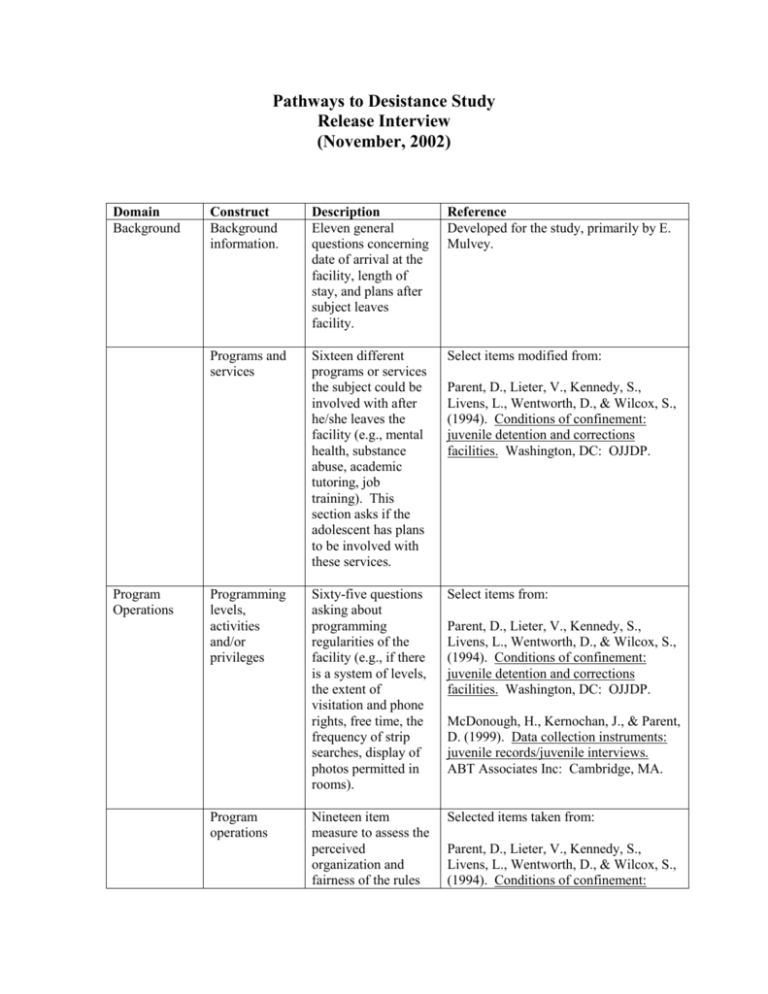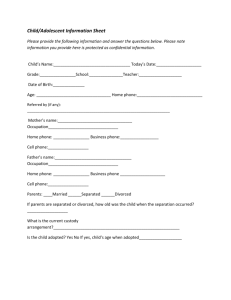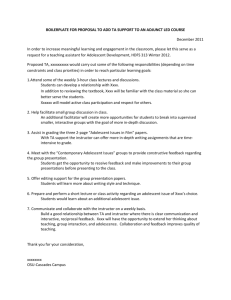Release Interview Reference List
advertisement

Pathways to Desistance Study Release Interview (November, 2002) Domain Background Program Operations Construct Background information. Description Eleven general questions concerning date of arrival at the facility, length of stay, and plans after subject leaves facility. Reference Developed for the study, primarily by E. Mulvey. Programs and services Sixteen different programs or services the subject could be involved with after he/she leaves the facility (e.g., mental health, substance abuse, academic tutoring, job training). This section asks if the adolescent has plans to be involved with these services. Select items modified from: Sixty-five questions asking about programming regularities of the facility (e.g., if there is a system of levels, the extent of visitation and phone rights, free time, the frequency of strip searches, display of photos permitted in rooms). Select items from: Nineteen item measure to assess the perceived organization and fairness of the rules Selected items taken from: Programming levels, activities and/or privileges Program operations Parent, D., Lieter, V., Kennedy, S., Livens, L., Wentworth, D., & Wilcox, S., (1994). Conditions of confinement: juvenile detention and corrections facilities. Washington, DC: OJJDP. Parent, D., Lieter, V., Kennedy, S., Livens, L., Wentworth, D., & Wilcox, S., (1994). Conditions of confinement: juvenile detention and corrections facilities. Washington, DC: OJJDP. McDonough, H., Kernochan, J., & Parent, D. (1999). Data collection instruments: juvenile records/juvenile interviews. ABT Associates Inc: Cambridge, MA. Parent, D., Lieter, V., Kennedy, S., Livens, L., Wentworth, D., & Wilcox, S., (1994). Conditions of confinement: of the facility, the staff’s interaction with the adolescents, and how safe the adolescents feel in the program/facility. juvenile detention and corrections facilities. Washington, DC: OJJDP. Fagan, J.A. (1998). Adolescent correctional interview. The correctional experience of adolescent felony offenders in adult and juvenile facilities. Unpublished instrument available from author. Moos, R., (1997). Evaluating treatment environments. New Brunswick, NJ: Transaction Publishers. Contact with caring adults Thirty-two questions that ask if there are influential individuals in the adolescent’s life who spend time with them or provide support. They have been modified to fit a staff/adolescent relationship. These items are revised versions of items in: Nakkula, MJ et al. (1990). Teenage risk prevention questionnaire and interview: an integrative assessment of adolescent high-risk behavior. Piscataway, NJ: Rutgers University, Graduate School of Applied and Professional Psychology. Phillips J, and Springer, F. (1992). Extended National Youth Sports Program 1991-92 evaluation highlights, part two: Individual Protective Factors Index (IPFI) and risk assessment study. Report prepared for the National Collegiate Athletic Association. Sacramento, CA: EMT Associates Research, 7(2), 156-176. Costs and rewards of offending Thirty-nine items that rate the perceived impact of the consequences received as a result of participation in criminal activity. Perceptions of Procedural Justice Twenty-five questions that ask about the adolescent’s perception of fairness and equity connected with treatment by the Northwestern Juvenile Project. (2000). Child and Family Assessment (CFA). Youth/Young Adult Interview. Developed for the study, primarily by J. Fagan. These questions were adapted from several studies of perceptions of procedural justice in adults. General references are: Casper, J., Tyler, T., and Fisher, B. (1988). Procedural justice in felony staff in the facility. cases. Law and Society Review, 22(3) 483-507. Tyler, T.R. (1990). Why People Obey the Law. New Haven: Yale University Press. Dimensions of Representativeness, Consistency, Correctability, Neutrality, Legitimacy are based upon: Tyler, T. (1997). Procedural fairness and compliance with the law. Swiss Journal of Economics and Statistics, 133 (2/2), 219-240. Paternoster, R., Brame, R., Bachman, R., and Sherman, L.W. (1997). Do fair procedures matter? The effect of procedural justice on spouse assault. Law and Society Review, 31, 163-204. Dimension of Legal Cynicism is based upon: Srole, L. (1956). Social integration and certain corollaries: An exploratory study. American Sociological Review, 21, 709716. Sampson, R.J. and Bartusch, D.J. (1999). Legal cynicism and tolerance of deviance: the neighborhood context of racial differences. Law and Society Review, 32(4), 777-804. Services Eight questions that ask if there are primary counselors assigned, if they change over time and how helpful they are. Items developed for the study, primarily by E. Mulvey Treatment Services A report of 12 different services received during the stay in the facility and the perceived helpfulness of each service. The services include: psychological services, drug and The Inventory of services was adapted from services research projects done regarding adolescent services. The categories of services were based on those used in: Burns, B., Angold, A., Magurder-Habib, K., Costello, E., Patrick, M. (1994). The Child and Adolescent Services Assessment (CASA). alcohol treatment, group therapy, religious services, family-based services, and anger management. Exposure to violence Alcohol and Drug Use/Abuse Mental Health Symptoms Eight items that assess the frequency of being a witness or being a victim to different violent acts (e.g., sexual attacks, attacks with weapons, fights). The items are revised versions of those found in: Twelve questions about use of and witnessing use of drugs and alcohol in the facility. Questions also address whether the subject has sold drugs or witnessed drugs being sold. Chassin, L., Rogosch, T., & Barrera, M., (1991). Substance use and symptomatology among adolescent children of alcoholics. Journal of Abnormal Psychology, 100(4), 449-463. The Brief Symptom Inventory is a widely used self-report measure that contains 53 items of mental health symptoms. There are nine subscales: psychoticism, somatization, depression, hostility, phobic anxiety, obsessivecompulsive, panic anxiety, paranoid ideation, and general anxiety. Three global indices can be generated: global severity index, positive symptom Derogatis, L., and Melisara, N. (1983). The Brief Symptom Inventory: an introductory report. Psychological Medicine, 13(3), 595-605. Selner-Ohagan, M., Kindlon, D., Buka, S., Raudenbush, S., and Earls, F. (1998). Assessing exposure to violence in urban youth. Journal of Child Psychology and Psychiatry and Allied Disciplines, 39(2), 215-224. Delucia, C., Belz, A., Chassin, L. (2001). Do adolescent symptomatology and family environment vary over time with fluctuations in paternal alcohol impairment? Developmental Psychology. 37(2), 215-224. total and positive symptom distress index. Peer Relationships and gang involvement within the facility. Forty questions to assess whether the adolescent was involved with a gang or the number of friends who engage in antisocial activity. The questions are asked about the friends in the facility. A subset (slightly revised) of the questions used in the Rochester Youth Study. The items chosen were based on recommendations by T. Thornberry at SUNY-Albany. Menard, S. and Elliott, D. (1996). Prediction of adult success using stepwise logistic regression analysis. A report prepared for the MacArthur Foundation by the MacArthur Chicago-Denver Neighborhood Project. Elliott, D.S., (1990). National Youth Survey. Institute of Behavioral Science. University of Colorado. Vocational or job training Twenty-nine questions that ask if the adolescent took part in any type of job training for computers, machinery, food service, home healthcare, retail/sales, or building trades and the perceived benefit of these programs. Includes items adapted from: Academic achievement and commitment Sixteen items about the importance of school, homework, grades, belonging, and teachers. Cernkovich, S. and Giordano, P. (1992). School bonding, race and delinquency. Criminology, 30(2), 261-291. Access to activities Eight questions asking if adolescents have access to a library, religious services, music and/or art classes, and recreation. McDonough, H., Kernochan, J., Parent, D. (1999). Diagnostic pages for programming outcome measures. ABT Associates Inc: Cambridge, MA. Fagan, J. A. (1998). Adolescent correctional interview. The correctional experience of adolescent felony offenders in adult and juvenile facilities. Unpublished instrument available from author. Parent, D., Lieter, V., Kennedy, S., Livens, L., Wentworth, D., & Wilcox, S., (1994). Conditions of confinement: juvenile detention and corrections facilities. Washington, DC: OJJDP. Perception of helpfulness of program in youth’s reintegration into the community. Eight items that measure how the adolescent feels about the program’s attempts to train adolescents to get jobs or to help them get into school programs. Perceptions of opportunities upon release. Twenty-four questions about the adolescent’s plans to get a job, go to school, earn a good living, have a place to live, to get married, have good family relations, and to stay out of trouble with the law once returning to the community and the chances of succeeding with these plans. Importance of staying out of trouble and overall helpfulness of the program. Four questions that ask the adolescent to rate the facility overall and how important it is to him/her to stay out of trouble when returning to the community. Includes select items from: Moos, R. (1997). Evaluating treatment Environments. New Brunswick, NJ: Transaction Publishers. Coates, R., Miller, A., & Ohlin, L. (1978). Diversity in a youth correctional system. Cambridge, MA: Ballinger Publishing Company. These questions were revised from the set used in the National Youth SurveyPrediction of Adult Success (Menard & Elliott, 1996). Elliot, D.S., (1990). National Youth Survey. Institute of Behavioral Science. University of Colorado. Includes select items from: Fagan, J. A. (1998). Adolescent Correctional Interview. The correctional experience of adolescent felony offenders in adult and juvenile facilities.Unpublished instrument available from the author.







